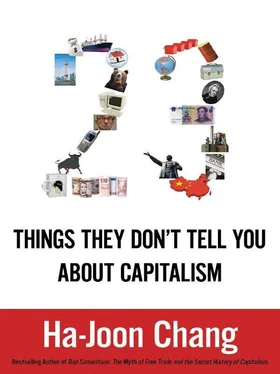So, free-market economists have deliberately taken advantage of people’s justified fears of hyperinflation in order to push for excessive anti-inflationary policies, which do more harm than good. This is bad enough, but it is worse than that. Anti-inflationary policies have not only harmed investment and growth but they have failed to achieve their supposed aim – that is, enhancing economic stability.
Since the 1980s, but especially since the 1990s, inflation control has been at the top of policy agendas in many countries. Countries were urged to check government spending, so that budget deficits would not fuel inflation. They were also encouraged to give political independence to the central bank, so that it could raise interest rates to high levels, if necessary against popular protests, which politicians would not be able to resist.
The struggle took time, but the beast called inflation has been tamed in the majority of countries in recent years. According to the IMF data, between 1990 and 2008, average inflation rate fell in 97 out of 162 countries, compared to the rates in the 1970s and 80s. The fight against inflation was particularly successful in the rich countries: inflation fell in all of them. Average inflation for the OECD countries (most of which are rich, although not all rich countries belong to the OECD) fell from 7.9 per cent to 2.6 per cent between the two periods (70s–80s vs. 90s–00s). The world, especially if you live in a rich country, has become more stable – or has it?
The fact is that the world has become more stable only if we regard low inflation as the sole indicator of economic stability, but it has not become more stable in the way most of us experience it.
One sense in which the world has become more unstable during the last three decades of free-market dominance and strong anti-inflationary policies is the increased frequency and extent of financial crises. According to a study by Kenneth Rogoff, a former chief economist of the IMF and now a professor at Harvard University, and Carmen Reinhart, a professor at the University of Maryland, virtually no country was in banking crisis between the end of the Second World War and the mid 1970s, when the world was much more unstable than today, when measured by inflation. Between the mid 1970s and the late 1980s, when inflation accelerated in many countries, the proportion of countries with banking crises rose to 5–10 per cent, weighted by their share of world income, seemingly confirming the inflation-centric view of the world. However, the proportion of countries with banking crises shot up to around 20 per cent in the mid 1990s, when we are supposed to have finally tamed the beast called inflation and attained the elusive goal of economic stability. The ratio then briefly fell to zero for a few years in the mid 2000s, but went up again to 35 per cent following the 2008 global financial crisis (and is likely to rise even further at the time of writing, that is, early 2010). [21] C. Reinhart and K. Rogoff, This Time is Different (Princeton University Press, Princeton and Oxford, 2008), p. 252, fig. 16.1.
Another sense in which the world has become more unstable during the last three decades is that job insecurity has increased for many people during this period. Job security has always been low in developing countries, but the share of insecure jobs in the so-called ‘informal sector’ – the collection of unregistered firms which do not pay taxes or observe laws, including those providing job security – has increased in many developing countries during the period, due to premature trade liberalization that destroyed a lot of secure ‘formal’ jobs in their industries. In the rich countries, job insecurity increased during the 1980s too, due to rising (compared to the 1950s–70s) unemployment, which was in large part a result of restrictive macroeconomic policies that put inflation control above everything else. Since the 1990s, unemployment has fallen, but job insecurity has still risen, compared to the pre-1980s period.
There are many reasons for this. First, the share of short-term jobs has risen in the majority of rich countries, although not hugely as some people think. Second, while those who keep their job may stay in the same job almost (although not quite) as long as their pre-1980s counterparts used to, a higher proportion of employment terminations have become involuntary, at least in some countries (especially the US). Third, especially in the UK and the US, jobs that had been predominantly secure even until the 1980s – managerial, clerical and professional jobs – have become insecure since the 1990s. Fourth, even if the job itself has remained secure, its nature and intensity have become subject to more frequent and bigger changes – very often for the worse. For example, according to a 1999 study for the Joseph Rowntree Foundation, the British social reform charity named after the famous Quaker philanthropist businessman, nearly two-thirds of British workers said they had experienced an increase in the speed or the intensity of work over the preceding five-year period. Last but not least, in many (although not all) rich countries, the welfare state has been cut back since the 1980s, so people feel more insecure, even if the objective probability of job loss is the same.
The point is that price stability is only one of the indicators of economic stability. In fact, for most people, it is not even the most important indicator. The most destabilizing events in most people’s lives are things like losing a job (or having it radically redefined) or having their houses repossessed in a financial crisis, and not rising prices, unless they are of a hyperinflationary magnitude (hand on heart, can you really tell the difference between a 4 per cent inflation and a 2 per cent one?). This is why taming inflation has not quite brought to most people the sense of stability that the anti-inflationary warriors had said it would.
Now, the coexistence of price stability (that is, low inflation) and the increase in non-price forms of economic instability, such as more frequent banking crises and greater job insecurity, is not a coincidence. All of them are the results of the same free-market policy package.
In the study cited above, Rogoff and Reinhart point out that the share of countries in banking crises is very closely related to the degree of international capital mobility. This increased international mobility is a key goal for free-market economists, who believe that a greater freedom of capital to move across borders would improve the efficiency of the use of capital ( see Thing 22 ). Consequently, they have pushed for capital market opening across the world, although recently they have been softening their position in this regard in relation to developing countries.
Likewise, increased job insecurity is a direct consequence of free-market policies. The insecurity manifested in high unemployment in the rich countries in the 1980s was the result of stringent anti-inflationary macroeconomic policies. Between the 1990s and the outbreak of the 2008 crisis, even though unemployment fell, the chance of involuntary job termination increased, the share of short-term jobs rose, jobs were more frequently redefined and work intensified for many jobs – all as a result of changes in labour market regulations that were intended to increase labour market flexibility and thus economic efficiency.
The free-market policy package, often known as the neo-liberal policy package, emphasizes lower inflation, greater capital mobility and greater job insecurity (euphemistically called greater labour market flexibility), essentially because it is mainly geared towards the interests of the holders of financial assets. Inflation control is emphasized because many financial assets have nominally fixed rates of return, so inflation reduces their real returns. Greater capital mobility is promoted because the main source of the ability for the holders of financial assets to reap higher returns than the holders of other (physical and human) assets is their ability to move around their assets more quickly ( see Thing 22 ). Greater labour market flexibility is demanded because, from the point of view of financial investors, making hiring and firing of the workers easier allows companies to be restructured more quickly, which means that they can be sold and bought more readily with better short-term balance sheets, bringing higher financial returns ( see Thing 2 ).
Читать дальше






![Ally Carter - [Gallagher Girls 01] I'd Tell You I Love You But Then I'd Have to Kill You](/books/262179/ally-carter-gallagher-girls-01-i-d-tell-you-i-lo-thumb.webp)





